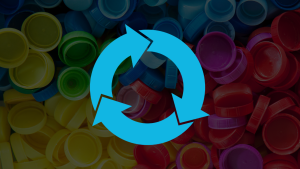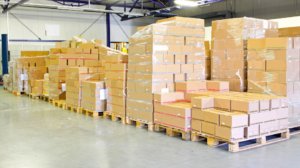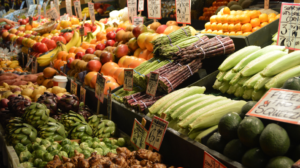Will recycled plastics survive tanking oil prices?
It seems an impossible situation. Some of the world’s largest corporations promised to quickly slash their use of virgin plastic packaging. Yet the recycled material available to make bottles, bags and boxes has become harder to find and more expensive.
Markets already jagged from COVID-19 saw the price of crude oil drop below zero for the first time April 20, which also dragged down the value of virgin plastics. In the last three months, pricing nose-dived by 42 percent for high-density polyethylene HDPE) used in laundry bottles, by 43 percent for polypropylene used in yogurt tubs and by 14 percent for PET used in water bottles, according to RecyclingMarkets.net. Post-consumer recycled plastics look about as budget-friendly as diamonds next to cubic zirconia.
“It’s the circle of life but not quite a circular economy,” said GreenBiz Co-founder Joel Makower, during the Circularity 20 Digital event Tuesday.
Where does this leave the businesses embracing circularity in plastics? More than 450 organizations have signed on to the New Plastics Economy commitment, sparked in 2018 by the Ellen MacArthur Foundation (EMF) and the U.N. Environment Program. The vision for fully reusable, recyclable or compostable plastic consumer packaging includes participants ranging from Ahold Delhaize and Apple to Zespri Group and ZigZag Global. Progress was being made toward adopting post-consumer recycled feedstocks. Some signatories were stepping up their initial commitments, creating road maps and reporting results.
But have rock-bottom oil prices and the pandemic doomed the market for recycled plastics? In North America, already the supply of post-consumer plastic resin could only meet 6 percent of the demand, Closed Loop Partners Executive Director Allison Shapiro, who specializes in circular economy investments, told the Circularity virtual audience. If every company set a goal of 25 percent post-consumer content, they simply could not meet it. At the same time, the end market drives everything upstream.
Headwinds and tailwinds
Companies that process or sell recycled plastics are in a tough spot. “We talk to many processors, many MRFs [materials recovery facilities], many collection and hauling companies every day,” Shapiro said. “They are unanimous in expressing their gratitude to corporate commitments. Everybody’s nervous that corporates may back out of their commitments.”
New Jersey-based GDB International makes post-consumer polyethylene pellets for filmy grocery bags. What sold for 45 cents a pound a few months ago barely could sell at 29 cents today, according to Sunil Bagaria, founder and president at GDB. California’s plastic bag ban had required reusable bags to include 40 percent recycled material, a plus for his business. The coronavirus crisis changed that overnight, when the state suddenly allowed throwaway shopping bags for public health reasons.
“The moment that law was put on hold every single manufacturer of plastic bags immediately switched to virgin resin,” Bagaria said.
More generally, however, the large corporate commitments that have been a tailwind to the recycling industry are also sustaining it right now, Shapiro noted. Packaged goods companies pledged to use an average of 22 percent recycled content in their packaging by 2025 through the New Plastics Economy, a fivefold increase over 2018 levels. And some of the biggest names in that program, including Unilever and Coca-Cola, say they’re not letting up, being committed for the long haul.
Ben Jordan, Coca-Cola’s senior director of environmental policy, acknowledged that low fossil oil prices and the pandemic may create hiccups along the way to reaching its goals for the next five and 10 years, but that doesn’t change the deeper horizon.
Coca-Cola is striving for 100 percent recyclability of all its packaging by 2025 and for 100 percent of its packaging that enters the marketplace to reach a recycling system by 2030. The company launched its “World Without Waste” campaign in 2018 to drive circularity in all of its packaging, including PET bottles, glass and aluminum. Additionally, it is aiming for 50 percent recycled material in its packaging by 2030. Coca-Cola already has solidified its 10-year sourcing plans for recycled PET (rPET) on each continent.
Jordan described these efforts as hinging upon progress in design and collection as well as partnerships with WWF, Ocean Conservancy, suppliers, governments, peers and even competitors. “I’ve spent more time with Pepsi people in the last two years than I had for the 22 years before that,” Jordan said.
Some Coca-Cola brands in 16 countries already use 100 percent rPET, as is all of its brands in Sweden. The company has experimented with recycling technologies, including creating a batch of the first food-grade bottles made from marine-waste plastic back in October. In some places it has lightened Sprite bottles from green to more valuable, clear PET.
What’s slowing down the progress on Coca-Cola’s circular ambitions lately is not just the pricing of rPET. A bigger issue in many parts of the world is that not enough used bottles are being retrieved for suppliers to meet its demand for rPET, Jordan said. Although most U.S. curbside recycling programs are humming along, the engines of informal waste collection in developing parts of the world have stalled while those laborers shelter in place.
“You’ve got to have enough bottles to come back through the recycling infrastructure to create the supply in the first place,” Jordan said. “When we look globally around the world, our A-No. 1 priority is getting the collection rate on our packaging up.”
Looking up
If cheap oil and the novel coronavirus aren’t eliminating the prospects for recycled plastic, then what will help the market? Even if oil prices remain low for years, it’s not impossible that the production of virgin plastic resin could slow at some point in response to an oversupply, making post-consumer plastic competitive again.
Reopening the economy should instill lasting confidence, freeing up markets as well as the networks of people collecting recyclables around the world — that is, unless COVID-19 infections spike upward again. The pause button will lift on textiles, automotive and other sectors on pause, which will help with PET beyond food uses, Shapiro said.
Consider GDB, which already weathered a major disruption when China closed its ports to imported waste for recycling. The firm’s bread and butter had been collecting plastic scrap for export, but it pivoted to recycling plastics itself. It’s fair to assume that if California reinstates its bag ban, buyers will return for Bagaria’s recycled pellets and he’ll potentially get back on track to ramp up volume and capacity again.



